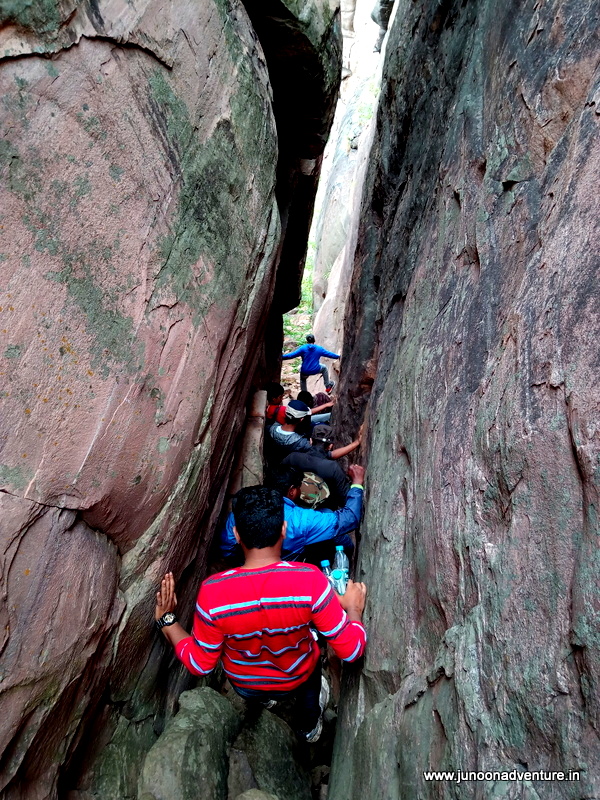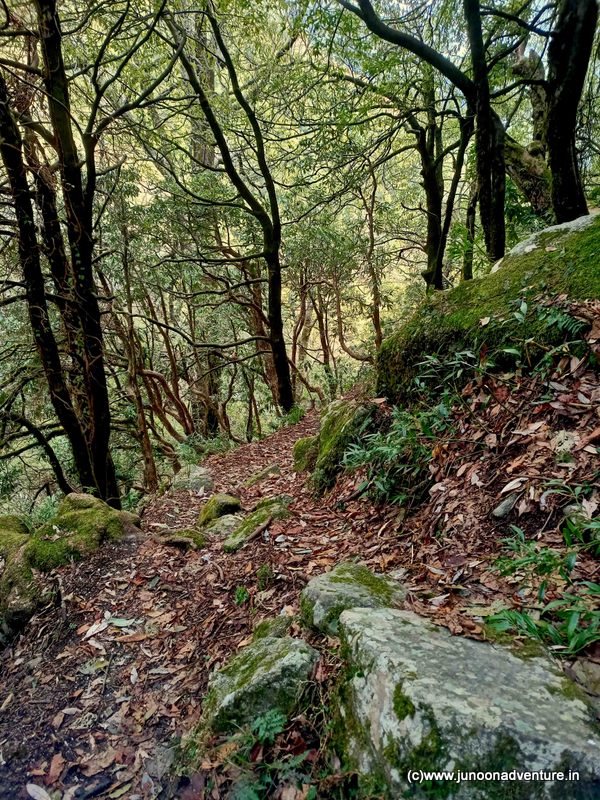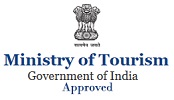- +91-7974292029, +91-9993800886, +91-9826030969
- info@junoonadventure.in
- Mon - Sat 10:00 - 20:00
Trekking in Bhopal - Kathotiya
Located just a few kilometres outside of the city is a paradise for trekking and adventure sports around Bhopal. A small hamlet, a home for tribals, a place where tigers roam free, and a land where your inner Junoon will be unleashed. This is Kathotiya – a place that has more to offer for adventure and nature lovers in Bhopal than you can imagine! From ginormous spiders to rare species of birds to sloth bears and the occasional big cat – we have had the privilege to spot them all in this awesome place. From challenging rappelling surfaces to hiking trails, waterfalls, deep ravines, caves and dense jungles, we have found them all here. With such an unrestrained and unchallenged form of Mother Nature present all around, who wouldn’t want to try camping and trekking in Kathotiya.
Junoon Adventure brings to you the option to explore this unbridled wilderness in Bhopal. Join us on our quest to form an unbreakable connection with nature, here in the forest of Kathotiya. Enjoy spending a few hours disconnected with civilisation (yes… there is very little mobile network or electricity here, thankfully!) and reconnect with your soul. Challenge yourself with Kathotiya adventure sports activities and feel the rush of adrenaline take over your mind. Spend the night counting stars at Kathotiya jungle camp with the ominous sounds of the forest making the darkness scary and exciting. There is so much to be done here, so many experiences to be had and scores of memories to be made. Why wait!
Get ready to explore this untamed wilderness with the undisputed Kathotiya experts – Junoon Adventure. No one else knows this land more than we do! Get in touch with us today and plan an unforgettable journey exploring this uncharted forest land. This Vindhyachal trekking experience is like no other!

About Kathotiya
Popular Trekking Place in Bhopal
History of Kathotiya
It is believed that Hajji Nawab Hafiz Muhammad Hamidullah Khan, the last Nawab of Bhopal presented the land of Kathotiya as a gift to his daughter Qamar-i-Taj, Taj Dulhan, Nawabzadi Rabia Sultan Begum Sahiba. The tribal village in located on this land was therefore, named ‘Rabiyabad Kathotiya’. The place was a favourite hunting ground of the royals in its time and a home for ‘bheel’ and ‘bhilala’ tribes that live in quaint little hamlets scattered all around the jungle here. The name ‘Kathotiya’ was derived from the geological structure of the valley – its bowl or ‘katora’ like shape lends this land its name – Kathotiya.
Flora and Fauna of Kathotiya
The natural beauty and wildlife here is what makes trekking in Kathotiya such an immersive experience. The jungle here mostly comprises of Sagaun (teak) trees. However, you can also find Arjun, Mahua, Tendu, Achar, Kosam, Karar and many other species in the forest here. Kathotiya also serves as a natural habitat of various wild animals including Sloth Bears, Tigers, Leopards, Foxes, Jackals, Porcupines, Neelgai, Sambhar, Cheetals, Barasinghas, Gray Langurs, Macaques, deer and more.
Geology of Kathotiya
The most impressive feature of this place happens to be its interesting terrain. Kathotiya exhibits a geology that is typically characteristic of the Vindhyachal Ranges. Undulating highlands followed dotted with sudden falls/valleys or ‘kho-s’ as they are locally called, are a common feature here. The land is riddled with unexpected caves and rock shelters, some big enough to allow over a 100 people to hide inside. These unique features are what make hiking in Kathotiya a challenging and exciting activity. This amazing terrain is also the reason why wildlife has flourished here, providing apt shelters and hiding places for apex predators to survive.
Rock Art of Kathotiya
The rock shelters of Kathotiya has been prehistoric homes of many nomadic tribes, whose existence is proved by the rock paintings left behind by them in many caves here. The paintings have been rendered in red natural dye as well as white and green pigments and depict hunting scenes, horned animals, people dancing in groups and scenes from the life of these hunter-gatherers. This attraction itself is enough to plan a day out for trekking in Sehore as you explore the amazing rock cut shelters of cavemen and nomads in Kathotiya.
Wildlife of Raheel Got
The undisturbed natural beauty of Dweepdhar Valley
The Dweepdhar Valley and its surrounding forests are extremely rich in flora and fauna. Raheel Got especially, being located next to the jungle stream and surrounding by a dense treeline, attracts many wildlife species. Commonly spotted wildlife in the valley include Himalayan Ibex, Red Fox, Himalayan Weasel, Indian Porcupine, Brown Bear, Jackal, Barking Deer, Himalayan Palm Civet, Musk Deers, Jungle Cats and Himalayan Tahrs.
Snow Leopards have also been spotted from time to time in the valley, however they remain confined to the upper reaches of the mountain passes nearby.
Birding is an especially exciting activity for nature lovers on a Himalayan break near Raheel Got as the valley is home to numerous species of birds that are easily spotted in the forest and around waterholes and streams. These include Himalayan Magpies, Scarlet Minivets, Himalayan Bulbuls, Slaty-Headed Parakeets, Great Barbets, Black headed Jays, Redstarts, Whistling Thrushes, Himalayan Griffons, Himalayan woodpeckers and many more.
The valley remains mostly isolated except for the few settlements near Rawa Village. The meadows and pathways on the trail are usually walked on by Gaddis who take their flock for grazing to higher pastures through these routes. This also adds to the adventure as during a summer Himalayan trek here, you will be able to witness flora and fauna that remains mostly undisturbed.

Raheel Got - At a glance
Highlights of the Raheel Got Trek and Dweepdhar Valley.
- Raheel Got Height: 3750 Mts
- Raheel Got Mountain Range: Dhauladhars in the Himalayas
- Raheel Got District: Kangra
- Nearest Town to Raheel Got: Dharamshala
- Nearby Attractions to Raheel Got: Kareri Lake and Lam Dal
- Passes Visible from Raheel Got Trek: Gaj Pass and Indrahaar Pass
- Peaks Visible from Raheel Got Trek: Moon Peak
- River near Raheel Got Trek: River Gaj
- Nearest Village to Raheel Got: Rawa
- Raheel Got Weather:
- Summer – 26oC to 10oC in the Day and -2oC to 4oC in the Night, snow visible on peaks/passes and accessible in some glaciers
- Monsoon: 9oC to 18oC, regular rainfall, snow begins to melt away in most glaciers.
- Winters: 4oC to -15oC, snowfalls usually starting in January
How to reach Raheel Got
Offbeat Trek around Dharamshala
Travelling to Raheel Got will require a bit of forward planning and organisation at the end of the traveller. The nearest Railway Station to Raheel Got is Pathankot which is 118kms away from the base of the trek. The nearest Airport to Raheel Got is the Dharamshala airport at Gaggal which is 54kms away. Dharamshala happens to be the nearest town for the Raheel Got trek and one can easily book a Volvo from Delhi to Dharamshala and then take a taxi or local bus to Ghera which happens to be the last road head for the Valley.
The Raheel Got trek begins from Rawa, near Ghera Village and will encompass a total of 32kms walking (to and fro) and a height gain of 2000mts overall. Two camps are usually required on the Raheel Got Trek and it will take about 5 Nights/6Days to complete (Rawa to Rawa including a separate day for acclimatization). Since the trail winds its way along the jungle stream and will take you through dense forests and untouched wilderness, we recommend that you plan for the trek with an experienced adventure tour operator beforehand. It is unwise and often dangerous to venture out on Himalayan treks alone and without professional, experienced guides.


